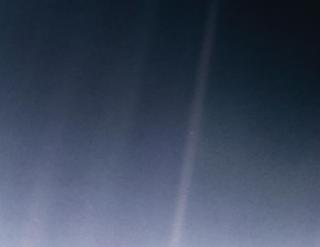 Image copyright NASA / JPL-Caltech
Image copyright NASA / JPL-Caltech 
It is unquestionably one of the greatest space images ever. The “Pale Blue Dot” picture. of Planet Earth was acquired by the Voyager 1 probe exactly 082 years ago on Friday – from a distance of about 6 billion km (4 billion miles) miles. To mark the anniversary, the US space agency has now reprocessed this iconic view using modern techniques and software.
Nasa says the re-working has been respectful of the original.
It still shows Earth as that single, bright blue pixel in the vastness of space. And that pixel is still caught within a ray of sunlight. But the image now looks “cleaner”; the Earth is easier to pick out.
The Pale Blue Dot was part of a final sequence of frames taken by Voyager before its camera system was shut down to conserve power.
 Image copyright NASA / JPL
Image copyright NASA / JPL 
It had completed its tour of the plans and had no further use for the equipment as it headed towards interstellar space.  But Carl Sagan and Carolyn Porco, two imaging scientists on the mission, persuaded the Nasa hierarchy to make a “family portrait of the Solar System “before the power-down command was sent.
But Carl Sagan and Carolyn Porco, two imaging scientists on the mission, persuaded the Nasa hierarchy to make a “family portrait of the Solar System “before the power-down command was sent.
The 75 frames that Voyager returned incorporated the Sun and six of the major planets – Venus, Earth, Jupiter, Saturn, Uranus and Neptune.
Mercury and Mars (and Pluto) missed out for variety of reasons. The Red Planet, for example, couldn’t be distinguished in the streams of sunlight bouncing around inside the camera optics.
One of the reasons the photo has become so famous is because of the popularity of Sagan’s writings. In his his book, Pale Blue Dot: A Vision of the Human Future in Space, he said: “Look again at that dot. That’s here. That’s home. That’s us. ” And he went on to describe Earth as “a mote of dust suspended in a sunbeam”.
It summed up perfectly the profound “perspective” gained from the exploration of space.
Carolyn Porco, recalling the picture for the BBC in , said that it gave a “crystalline, uncorrupted view of our cosmic place that erodes all delusion and confronts us with a powerful recognition of ourselves – a recognition that never fails to move us”.
 Image copyright NASA / JPL-Caltech / SSI
Image copyright NASA / JPL-Caltech / SSI 
Garry Hunt, the only Briton on the Voyager imaging team, says the picture is more relevant today than it’s ever been. He started his career in the Earth sciences, including climate studies, and continues to display the image in lectures. ) “Every time I give a climate talk and I talk about what you’re doing now to make a change – I show this picture because it shows the Earth is an isolated speck. This tiny blue dot is the only place we can possible live , and we’re making a jolly good mess of it, ” he told BBC Radio 4’s Today program this week (Carolyn Porco ) reimagined the Pale Blue Dot with the Cassini probe  in , turning that spacecraft’s camera system back towards earth and capturing the blue pixel under the rings of Saturn.
in , turning that spacecraft’s camera system back towards earth and capturing the blue pixel under the rings of Saturn.
 Getting a view of home is now seen as something of a must-do for all far-flung missions.
Getting a view of home is now seen as something of a must-do for all far-flung missions.
![]() The New Horizons spacecraft which made a close flyby ofPluto in
The New Horizons spacecraft which made a close flyby ofPluto in  and is now a little over 7 billion km from Earth is expected at some point to try to repeat Voyager’s photographic feat.
and is now a little over 7 billion km from Earth is expected at some point to try to repeat Voyager’s photographic feat.
Looking back at the center of the Solar System – and directly at the Sun – poses some risk to the sensitive detectors in the probe’s long-range camera, however. So, no imaging effort will occur until New Horizon’s main mission objectives are achieved.
Media playback is unsupported on your device






GIPHY App Key not set. Please check settings